The iPhone 7 and iPhone 7 Plus Review: Iterating on a Flagship
by Joshua Ho & Brandon Chester on October 10, 2016 8:00 AM EST- Posted in
- Smartphones
- Apple
- Mobile
- iOS
- iOS 10
- iPhone 7
- iPhone 7 Plus
GPU Performance
Section by Brandon Chester
Now that the general system and CPU performance of A10 Fusion has been characterized, we can move on to more focused benchmarks for the GPU and the storage subsystem. Apple's keynote for the iPhone 7 actually disclosed that the GPU in A10 Fusion is a six core part. The last time I recall Apple mentioning specifics about their GPU was with the launch of the iPad 3, where the GPU was advertised as a quad core implementation that turned out to be SGX543MP4.
The use of a six core GPU is interesting because there's not much choice for Apple given that A9 also used the six core PowerVR GT7600. It really boils down to three possibilities. The first is that Apple has actually continued using the exact same GT7600 microarchitecture as on the A9, albeit with an improved layout on the die. The second is that Apple has moved to PowerVR GT7600 Plus, which brings some improvements to integer compute performance, and memory bandwidth optimizations. And the third is the wildcard option - that Apple has put to use its significant GPU engineering resources on a more customized design; something that's still using the PowerVR architecture, but more custom than ever before. This is a longer discussion to have in our full deep dive, but Ryan's of the opinion that this is somewhere between options two and three, that Apple has done some significant work to produce a highly optimized version of the PowerVR GT7600 Plus
In any case, as Apple isn't using a radically different GPU architecture, most of Apple's stated 50% increase in GPU power comes from increasing the clock speeds, with optimizations such as memory and caching picking up the rest. This is interesting because Apple also advertises that A10 Fusion's GPU uses only two thirds the power of A9, which would indicate a lot of work done by Apple to optimize for power usage.


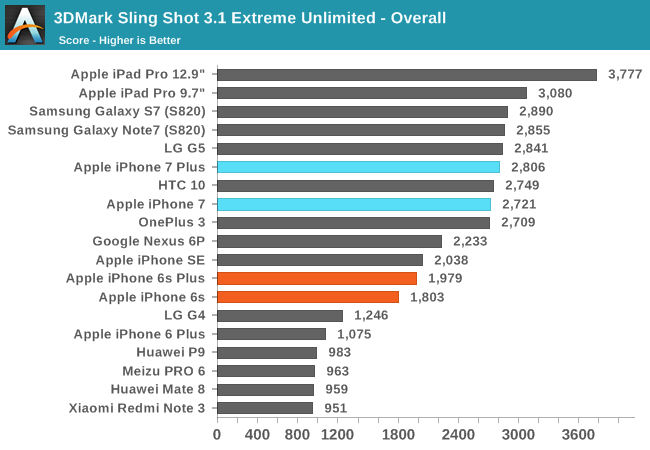
3DMark Sling Shot is broken down into a few different tests, and at the end the results of graphics tests and physics tests produce separate scores which are then used to generate an overall score.
In the graphics test the results are in line with Apple's stated GPU performance improvement of 50%. The physics score, which is really a CPU test, only improves by 30-35%, which has a direct correlation to the increase in peak clock speed from 1.8GHz on A9 to 2.3GHz in A10 fusion.
Like Ice Storm, the physics test is still basically a chart of devices ranked by cores multiplied by max frequency, and you can see that the iPhones have improved very little over the years, with the improvements tracking closely to Apple's increases in CPU clock speed. This comes down to the test being designed in such a way that there's little instruction level parallelism to exploit due to memory dependencies, which puts Apple's wide dual core CPU at a disadvantage. While it is certainly a valid test situation, it's not really reflective of actual 3D game performance because you would generally not write a game in such a way that it cannot exploit the performance of its target hardware.
Even with the smaller improvement in the physics tests, the overall score for the iPhone 7 is still roughly 50% higher than the Apple A9 devices like the iPhone 6s and SE.
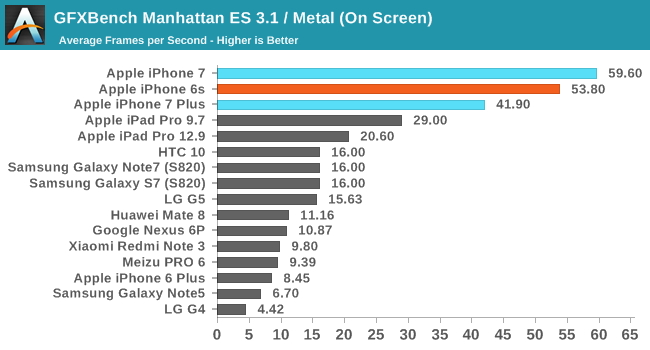
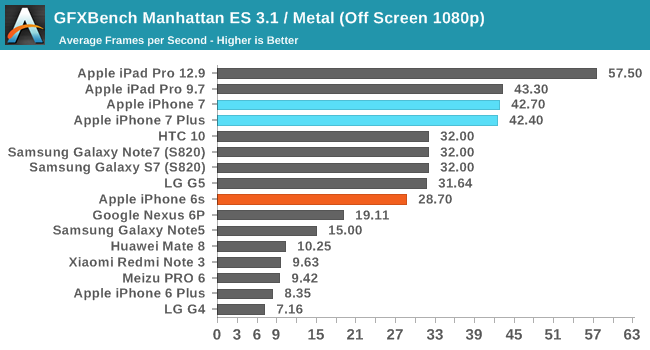
We originally migrated away from Manhattan ES 3.0 to Manhattan ES 3.1 / Metal to push back on devices hitting VSync in the on screen tests. Unfortunately it didn't work for long. With the iPhone 7's increase in GPU performance not being accompanied by an increase in display resolution, the on screen result in GFXBench Manhattan is higher than any other device, and is essentially at the display's refresh limit. The iPhone 7 Plus isn't able to hit Vsync due to its higher resolution, but the on screen result of roughly 42fps is nothing to scoff at either considering the visual complexity of the test.
While on screen performance is helpful from the perspective of someone who wants to see how the phone will actually perform when running a game at its native resolution, to compare directly between devices you need to standardize the rendering resolution. As its name implies, GFXBench's off screen test simply renders all the frames at 1080p in an off screen buffer. In this test the iPhone 7 and 7 Plus both run slightly below 43fps, which puts them right where you'd expect from Apple's claim of 50% greater GPU performance. In GFXBench this also puts the two of them at the same level as the 9.7" iPad Pro for absolute GPU performance.
This gives some interesting insight into the relative clock speeds that Apple is running their GPUs at, as A9X uses a twelve core PowerVR Series7XT GPU, while A10 Fusion uses only six. As I mentioned before, the performance improvements in A10 Fusion primarily come from increasing the peak clock speed. Matching the 9.7" iPad Pro's A9X suggests that Apple has targeted a fairly aggressive clock speed for the GPU in A10 Fusion, and while we can't verify Apple's claim of A10's GPU running at only two thirds the power of A9, if that is indeed the case it would represent a great deal of optimization effort on Apple's part to achieve that despite increasing clock speeds this significantly.
Storage Performance
One of the big changes that came with Apple's A9 and A9X SoCs was a new storage controller designed internally at Apple. This was not the first Apple product to use an in-house SSD controller, as the 2015 MacBook used a PCIe SSD and adopted the NVMe interface. A9 and A9X adapted this for use in mobile, and the sequentual performance in particular was far ahead of anything in a competing mobile device.
Apple hasn't advertised any improvements to storage performance with A10 Fusion, but it's worth running tests to verify that performance has remained at the same level. There are also potential gains in write performance when increasing the total capacity of an SSD by adding additional dies. At this point there's really no benchmark that can give comperable results between iOS and Android, so I've decided against doing a cross-platform comparison here.
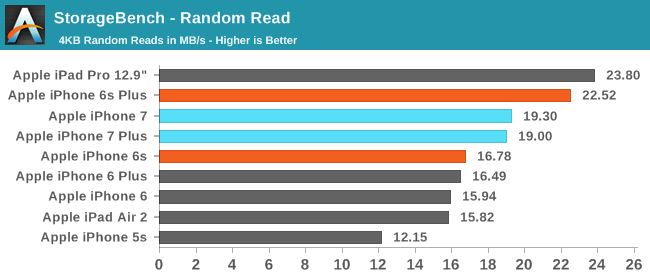
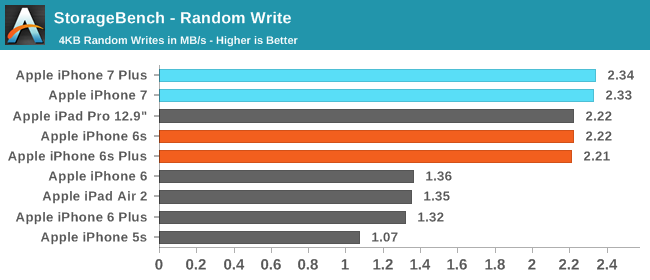

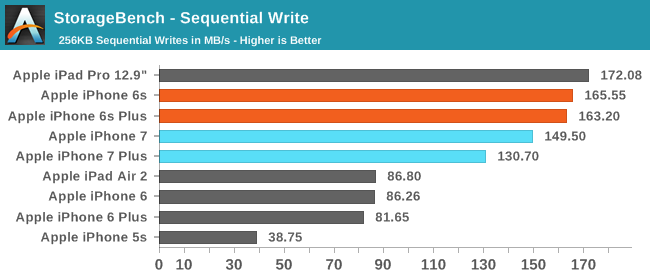
In general, the NAND performance of the iPhone 7 and 7 Plus is equivalent to the iPhone 6s and 6s Plus. There are some minor differences, but essentially all of them can be attributed to testing variance. The only thing that is worth noting is that there's no significant improvement to write performance even though the iPhone 7 units tested are 256GB models while the 6s and 6s Plus were 128GB models. This suggests that the NAND packages use higher capacity dies so there's no additional parallelism to take advantage of.










377 Comments
View All Comments
lolipopman - Tuesday, October 11, 2016 - link
I agree that Apple rules the market currently.*Currently*. It actually seems that the recently announced ARM A73 will be a beast.
And let's not forget the Mali G71 which is said to be very close to Nvidia Shield's performance.
I'm curious what the A11 chip will be bringing to the graphics table when the next revision of iPhones drop.
jospoortvliet - Tuesday, October 11, 2016 - link
Sadly the A73 won't even make a dent, it is maybe 20% faster at same power, that isn't a third of the gap with Apple...GPUs are doing better indeed but with far higher pixel densities end user experience is still that much worse.
tuxRoller - Tuesday, October 11, 2016 - link
Unfortunately it won't. The a73 looks to be quite good at efficiency, but per clock perf is still going to be decently far behind.As for graphics, no one can match IMG for efficiency. I really wish arm/Softbank would buy IMG.
ex2bot - Wednesday, October 12, 2016 - link
Android has been competitive in many areas and just plain better in some important ones (customization, screen quality, flexibility, choice), but the truth is that Qualcomm fell behind in perf with the 810 and 820. It looks like the 821 is close in performance.Secondly, the 7 and 7 Plus are most likely going to show better battery life because they have bigger batteries than the 6s and 6S Plus.
CloudWiz - Thursday, October 13, 2016 - link
821 is just a clocked-bumped 820, the performance difference between 820 and 821 will be less than 10%. Kryo is currently twice as slow as Hurricane in ST and far less efficient.cknobman - Monday, October 10, 2016 - link
I'm just going to reference this: http://www.windowscentral.com/best-smartphone-came...This was a blind test of over 13000 people voting on pictures taken in many many different scenarios. It compared 4 of the top smartphone cameras (which one of which was the iPhone 7).
The Galaxy S7 won by a landslide, not even close.
The iPhone 7 has its own drawbacks largely ignored by this review.
The lack of a headphone jack is a bigger issue that anyone makes it out to be and iOS is a terribly hindered OS that makes using any iPhone an painful experience.
Sure the battery life is good/great but this is largely because Apple choosing to remain so far back in their resolution. If you live in a Apple box and only look at their devices then sure its fine.
But go use any of the dozens of non Apple phones out there and then come back to an iPhone (especially the plus) and you immediately notice the lowered resolution and display quality.
The Garden Variety - Monday, October 10, 2016 - link
I was in tears and the injustice of this "review" until I read your supportive, nurturing reply. Thank you for giving all of us hope. Hope that the truth will reign, and that someday tech "journalists" will be exposed and jailed for their obvious bias. JAILED.cknobman - Monday, October 10, 2016 - link
LOL Your butthurt was so painful it seems you could not even comprehend what I wrote.I never called out the reviewer for bias or injustice but you apparently only choose to read/see/envision what you want...............either that or you are just plain stupid.
grayson_carr - Monday, October 10, 2016 - link
Let me propose a scenario. You have two identical displays. One is perfectly calibrated. One has the color saturation boosted and does not display colors accurately. If you pull a bunch of people off the street and have them look at both displays and vote on which one looks better, which one do you think they are going to pick? Answer: They are going to say the one with boosted saturation is better despite it being an identical display with objectively worse calibration. The average person does not know what is good, which is why I think blind photo comparisons are stupid. Now I'm not saying the Galaxy S7 doesn't have the best camera in a phone. The Galaxy S7 probably does have the best camera in a phone (in stills at least, video sucks). But I would much rather hear it from a professional photographer than a bunch of average Joes that know nothing about photography or cameras. That's just me.menting - Monday, October 10, 2016 - link
a professional photographer will probably feel insulted to even consider a rating a photo from a phone.